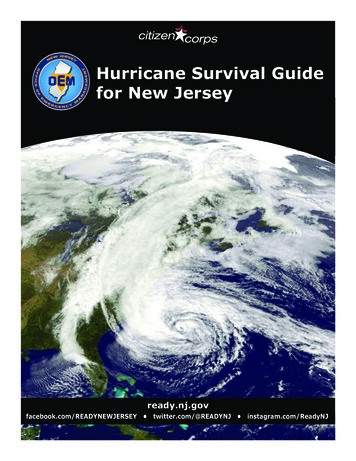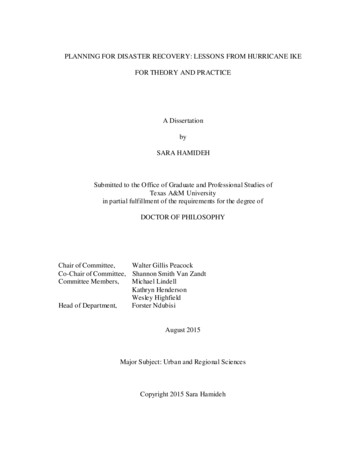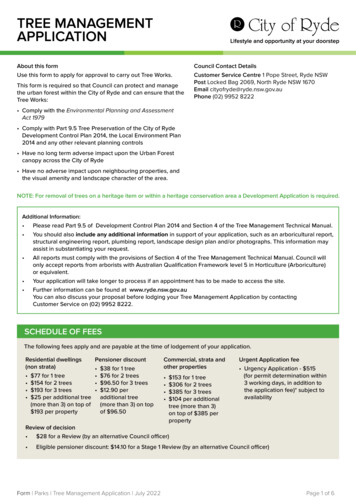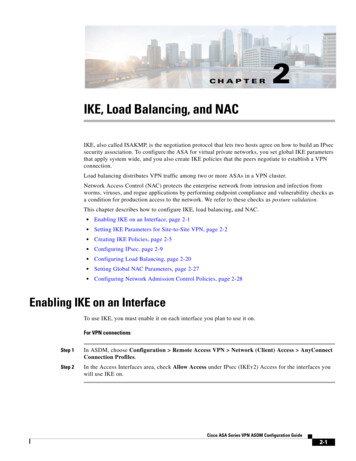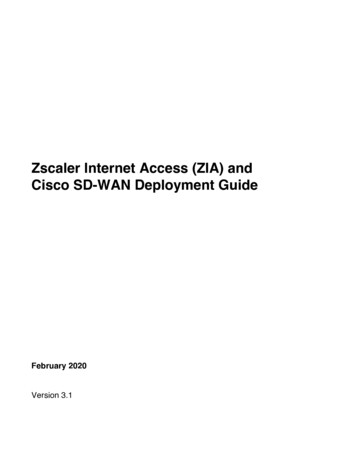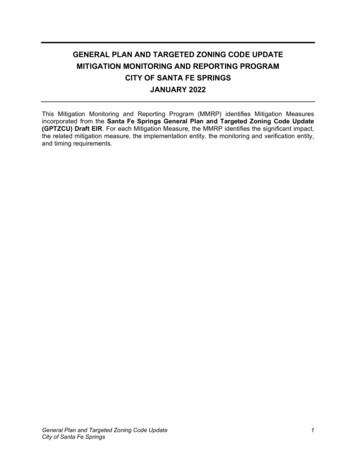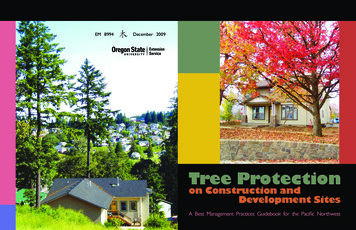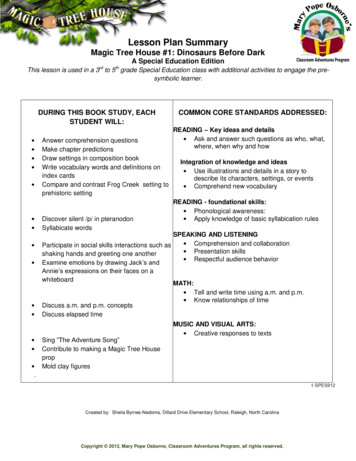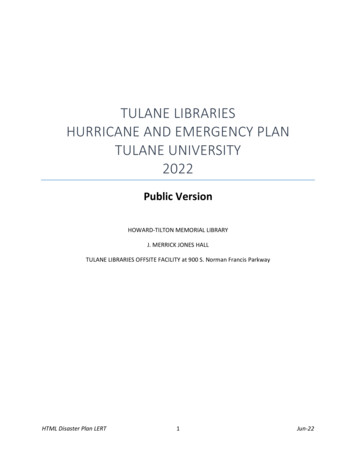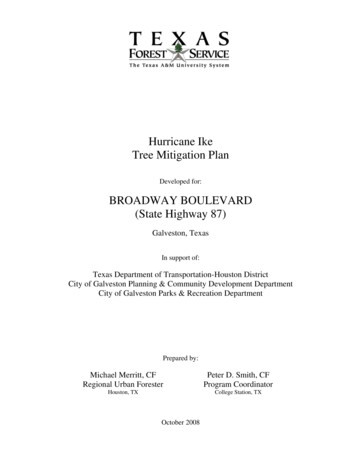
Transcription
Hurricane IkeTree Mitigation PlanDeveloped for:BROADWAY BOULEVARD(State Highway 87)Galveston, TexasIn support of:Texas Department of Transportation-Houston DistrictCity of Galveston Planning & Community Development DepartmentCity of Galveston Parks & Recreation DepartmentPrepared by:Michael Merritt, CFRegional Urban ForesterPeter D. Smith, CFProgram CoordinatorHouston, TXCollege Station, TXOctober 2008
Responding to Hurricane IkeOn September 12-13, 2008, Hurricane Ike slammed into Galveston Island with 110-mile perhour winds and a 15-foot storm surge, inundating most of this barrier island as well as the City ofGalveston. In addition to flooded homes and businesses, many of the city’s historic trees werealso damaged or destroyed. City leaders quickly recognized that wholesale removal of right-ofway (ROW) trees following the storm would forever alter the historic nature of Galveston andpose a barrier to long-term recovery. At the request of the Galveston Planning & CommunityDevelopment Department’s Historic Preservation officer, Texas Forest Service (TFS) urbanforesters Mickey Merritt and Pete Smith came to Galveston on September 17, 2008, to begindamage assessments of trees in the Historic Districts and along Broadway Boulevard.The goal of this assessment phase was to avoid the unintentional and unnecessary removal ofpublic trees during debris clearing activities within four historic districts. The process included abrief, visual inspection of storm-damaged trees that posed an immediate risk to the public space(sidewalks, streets) or adjacent property (homes) due to uprooting, excessive lean ( 30 degreeangle), crown loss (in excess of 50%), or trunk fractures (standards from the FEMA 325 DebrisManagement Guide). Each tree that met the standard for removal was marked with orange paintand photographed. TFS foresters completed tree assessments in the National Landmark (6th-19thStreets, north of Broadway), Cedar Lawn, Lost Bayou, and Silk Stocking historic districts onSeptember 18.Following this initial visit, we returned on September 30 tofocus our attention on Broadway Boulevard (StateHighway 87), which is the main thoroughfare throughGalveston. We completed the assessment on October 2 anddocumented a total of 35 trees that posed a risk to thepublic right-of-way and qualified for removal according tothe FEMA standards. Of these trees, 28 were on the groundalready and seven were marked because of significant rootplate shifting or excessive lean. Of the seven, two were onprivate property but leaning over the sidewalk, two werecity-owned trees along the right-of-way, and three werewithin the medians. The different species documented forremoval included live oak, magnolia, palm, and pecan.Live oak marked for removal due to root plate liftingWhile performing these assessments it quickly became apparent that almost all of the trees inGalveston were suffering from excessive salt exposure – either from wind-borne salt spray, thestorm surge, or both. Within two weeks, most trees and plants showed brown leaves that werequickly being shed, including the live oaks on Broadway. Very few tree species were sparedfrom this damage, the most notable exceptions being the various species of palm. Our immediateimpression was that the salt deposited by the storm surge would not allow the trees to recoverquickly without some sort of intervention. Since very little rain has fallen since Ike made landfalland the historic trees along Broadway have very high value to the community, we believe atreatment plan is necessary to mitigate the damage incurred from Hurricane Ike to theseremaining trees. The recommendations that follow are specifically directed at the trees onBroadway, but many of them can – and should – be applied to other city trees.-1-
Broadway Boulevard Tree Mitigation PlanThis treatment plan is prepared for the trees along Broadway Boulevard within the City ofGalveston, Texas, which were damaged by Hurricane Ike on September 12–13, 2008. TexasForest Service foresters conducted storm damage assessments of the above-ground portions ofthe trees within center medians and along the right-of-way (up to the adjacent propertyboundary), as well as the soil conditions within the medians, in order to design a simple, costeffective prescription to restore these historic trees to optimum health.Treatment ObjectivesImmediate Objectives:1. Lower the risk to lives and property from trees that suffered structural damage duringHurricane Ike.2. Remediate salt damage to the root zones of the remaining median trees caused by thestorm surge. Improve the soil environment to stimulate optimum growth for all trees.3. Replace trees lost in the storm and replant all vacant planting sites.Long-term Objectives:4. Establish clear maintenance policies and train city crews in proper tree care practices.5. Maintain public safety through effective monitoring of trees.6. Increase the resistance to, and resilience from, future hurricanes.Site DescriptionBroadway Boulevard (SH 87) is the main historic thoroughfare through the City of Galveston. Itbegins where I-45 ends, at 59th street, and continues for 3.8 miles, ending at Seawall Boulevard.Broadway has three lanes for vehicular traffic in both directions, plus a lane for on-street parkingfor most of its length. The east and westbound traffic lanes are separated by a series of widemedians that are broken at each street intersection, forming a total of 53 separate medians thataverage 290 feet long by 30 feet wide.Broadway is a state highway, so official jurisdictionbelongs to the Texas Department of Transportation(TxDOT). An old maintenance agreement from the 1960’stransfers the day-to-day maintenance of the medians –principally mowing – to the city, but there remains someuncertainty on the topic of tree maintenance. Tocomplicate matters, adjoining property owners sometimesmaintain the trees in front of their property between thesidewalk and the curb. TxDOT shares the cost of periodiclandscaping improvements to the medians with the cityand is in the process of implementing a 1.2 millionlandscape plan that will add irrigation and flower beds tothe ends of each median.-2-Map of Galveston, TX and Broadway Boulevard
Description and Condition of TreesForty-six of the medians along Broadway have live oak (Quercus virginiana) and palm(Washingtonia spp.) trees, planted in two matching rows; the seven medians closest to SeawallBoulevard (and the Gulf of Mexico) are planted exclusively with palms. It is unclear exactlywhen the trees were planted; some were planted in the early 1900’s after Galveston Island wasraised and others were planted as memorial trees following one or both World Wars. The oaktrees range in size from 10” in diameter (diameter-at-breast-height, or DBH) to over 24” DBH;the palms are approximately 50 feet tall and show few symptoms of damage or decline. Very fewyoung trees exist and there does not appear to be an active re-planting program at this time.Neither TxDOT nor the city of Galveston has a formal tree management or maintenance plan forthe trees along Broadway.As a general observation, the pre-storm condition of the oak trees along Broadway ranged from‘fair’ to ‘good’, but most suffered damage from the hurricane. Twenty-six median and sevenROW trees were either blown down or marked for removal by TFS. Though the vast majority ofoaks survived, the wind damage to their crowns ranges from light to severe. As of October 2008,TxDOT crews were in the process of removing the debris and marked trees from the mediansand ROWs. Safety pruning work to remove broken branches ( 2” diameter) on the remainingtrees is pending.There are some instances where the root flare of a tree – the point where the trunk joins the firstmajor roots – is obscured by the soil, often a factor that predisposes trees to health problems.This condition appears to pre-date Hurricane Ike and may be a result of the gradual raising ofBroadway each time a new surface is laid on the roadway. The natural tendency now is for waterand other materials to flow into the medians, rather than away from them, meaning that treesplanted in low spots will see an accumulation of soil and material near their trunks. While theadditional water may be beneficial, a buried root flare reduces gas exchange in the roots and canpromote conditions that lead to disease, decay, and tree failure.A more pressing problem, though, is that all of the oaktrees are showing signs of salt damage, either from seaspray or the storm surge. High levels of sodium (chemicalsymbol Na) can interfere with water absorption and resultin “burned” leaves, causing them to brown and fall off. Inthe weeks since the hurricane, some trees have begun toput on new leaves, which is a good sign. However, sincesalt levels may persist in the soil for some time, these newleaves may also burn and drop. If the trees cycle throughjust one or two flushes we believe most of the trees willsurvive; however, trees that cannot maintain a healthycrown of leaves because of high soil salt levels will spiralinto decline and, possibly, death.City crews watering trees to leach salt from the soilEven before a recommendation by TFS and TxDOT, city parks department crews began awatering program to leach the salt from the root zones and speed the recovery of these valuabletrees. In addition, TFS conducted a survey of the actual soil properties within these medians inorder to make specific treatment recommendations beyond this simple watering program.-3-
Soil Sampling & ResultsThe published soil survey for Galveston County (Soil Conservation Service, /TX167/0/galveston.pdf) lists the predominant soiltype on Broadway and the built areas of Galveston Islandas “Galveston-Urban land complex” (Gd). “This complexconsists of a nearly level, somewhat excessively drained,nonsaline, sandy soil and Urban land . An average ofabout 5 feet of sandy material, which was dredged frombay and canals, has been added to the original soil surfacein these areas.” (p. 19)To test soil properties, TFS pulled four to five soil cores(12-16” deep, totaling approximately one cup) from everyfifth median, for a total of ten samples over the 53separate medians. In addition, we took one sample from aright-of-way and another sample (S-11) tested soil fromSoil core removed for analysisjust the upper 3” of median soil. These 11 samples wereanalyzed by A&L Analytical Laboratories, Inc., of Memphis, TN, for texture, pH, organicmatter, nutrients, and the sodium (Na) level. Results are summarized in Table 1 and thecomplete sample reports are included with this report.Table 1: Soil Analysis S‐8S‐9S‐10S‐11Soil TextureClassloamy sandloamy sandloamy sandsandy loamloamy sandloamy sandloamy sandloamy sandloamy sandsandy loamRight‐of‐way diumHighHigh7.93.0%HighSoil texture class by % sand, silt, and clay particlesSeveral key findings inform our recommendations. As we suspected, most of the samplesshowed high sodium levels, meaning a treatment plan is warranted. Sample S-11 showed thehighest sodium value (4,886 lbs./acre), meaning that the highest levels of salt are still near thesurface.Second, all the medians have very sandy soil texture, as shown in the shaded area of the soiltexture triangle. This makes leaching of the salts feasible with watering alone. On clay soils,gypsum is sometimes added to chemically release the sodium ions into solution so that wateringwill wash them away.-4-
Third, the soil pH ranges from 7.6 to 8.1, which is considered mildly alkaline and not optimumfor tree growth. Trees prefer slightly acid soils below 7.0 (neutral) for best nutrient uptake andgrowth. Finally, all the samples showed low levels of organic matter – well below the optimumvalue of 5% – which is critical for root growth, nutrient and water uptake, and buffering from theextremes of this highly-urbanized environment.Short-term Recommendations (immediate-3 years)1. Public Safety: Complete the removal of debris, stumps, and standing trees marked for removal. Broken limbs greater than 2” in diameter that pose risk to pedestrian or vehiculartraffic should be located and removed as soon as possible.2. Soil Remediation: Watering will help leach salt levels out of the soil. All trees should receive 8 to 10gallons per diameter-inch at least once a week as long as rainfall is less than 1-inchper week. This program should continue into mid-winter 2009. Lower the soil pH by applying elemental sulfur at a rate of 5 lbs./1000 ft.2. Since theeffects of elemental sulfur are localized and temporary, this treatment should berepeated every three months (4 applications/year) for at least the next three years.Test soil pH and Na levels annually, before treatment. Apply a one-inch layer of non-manure compost to all medians, once annually, for thenext few years. Compost will improve soil structure, increase nutrient-holdingcapacity, reduce soil compaction and crusting, reduce fertilizer requirements, andimprove root growth. Apply a 2-3” layer of mulch – such as shredded hardwood material – after spreadingthe compost. Mulch will help the soil retain moisture, reduce soil compaction,suppress weeds, and protect tree roots, trunk, and bark from mechanical damage.Mulch also decomposes and becomes organic matter for the soil, and reduces oreliminates the need for mowing. Reapply each year for the next three years.3. Tree Replacement: Begin a program to replace all trees lost during Hurricane Ike. Since additional treesmay not survive the saltwater inundation, new trees should be planted during thedormant season for each of the next three years. Purchase high-quality plant materialwith a minimum 3-inch caliper trunk; larger trees may be brought in as “boxed” treesor by using a tree spade. Avoid material that would require extensive staking. Establish a community fund for tree planting. A partnership between the city, localbusinesses, foundations, the local historical society, and citizens can galvanizesupport for restoring this important community asset. Beyond the Broadway medians,many other public trees in Galveston have been lost and having a fund to share thecost of replacement will speed the re-greening process along.-5-
Long-term Recommendations (2-10 years)4. Tree Maintenance: Conduct a crown “cleaning” of all remaining Broadway oak trees, within the mediansand along the ROW. Crown cleaning is a selective pruning method used by arboriststo remove only dead, diseased, or broken limbs. No live limbs should be removedduring this operation to keep as much live foliage on the trees as possible to speedtheir recovery. Establish a set of formal pruning standards for work to be performed on all city trees.A commonly used set of standards is the latest ANSI A-300 Standards for Tree CareOperations. Additional policies may apply to the historic trees on Broadway. Cityworkers that perform any tasks (including mowing) near trees should attendappropriate training classes; those with responsibility for tree work should becomeCertified Arborists through the International Society of Arboriculture (ISA). Develop a long-term management plan for these historic trees. This plan shouldincorporate a GPS-based inventory of size, condition, and species for existing trees aswell as potential planting sites. Inventory work can often be accomplished usingtrained volunteers such as Master Gardeners or Master Naturalists. The plan shouldinclude a monitoring standard for reviewing safety of the trees along this busythoroughfare, as well as practices that are likely to reduce damage from future storms.A written plan for replacing and restoring the Broadway trees is important to guidethe annual treatments over the next decade. Use a professional arborist or urban forester to write the plan and guide the work.This can be accomplished through a professional services contract, but the city shouldconsider adding a staff member with these credentials to guide the management of allcity owned trees.5. Advocacy: Establish an advocacy group or “trees committee” to support the care and restorationof historic trees on the Island. Such a support group can help educate the communityon the benefits of trees, provide valuable input during plan development, and seeksources of funding to implement the recommendations of the plan. Big and historictrees capture the imagination of citizens, so the Broadway trees provide a ready-madeplatform for advocacy and fundraising in Galveston.Acknowledgements & ReferencesThe Texas Forest Service would like to thank the following their assistance: Walter Hambrick, TxDOT, Houston, TX Dr. Todd Watson, Texas A&M University, College Station, TX Anthony Camarino, Texas AgriLife Extension, Houston, TX Brian Scott, TFS Urban Forester, Amarillo, TXWeb references that discuss how to influence soil e/gypsum.html.-6-
treatment plan is necessary to mitigate the damage incurred from Hurricane Ike to these remaining trees. The recommendations that follow are specifically directed at the trees on Broadway, but many of them can - and should - be applied to other city trees. . the trees within center medians and along the right-of-way (up to the adjacent .
